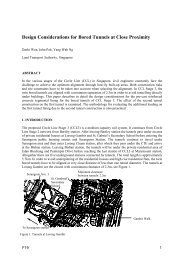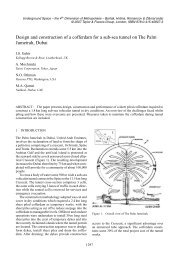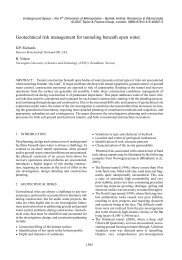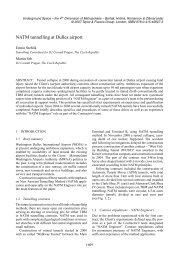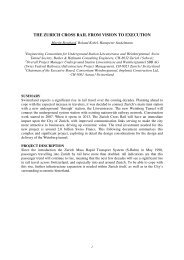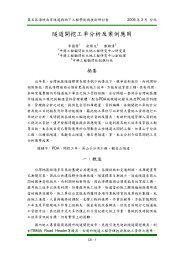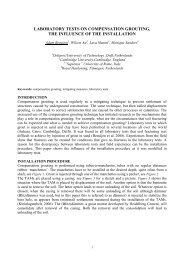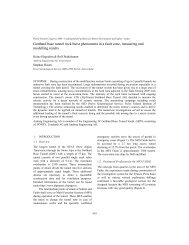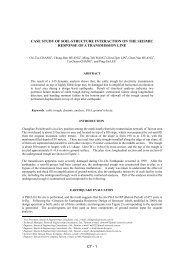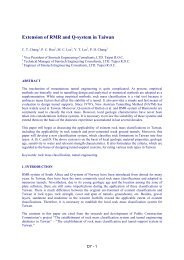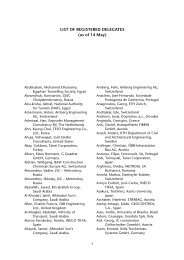Volume changes in grout used to fill up the tail void
Volume changes in grout used to fill up the tail void
Volume changes in grout used to fill up the tail void
Create successful ePaper yourself
Turn your PDF publications into a flip-book with our unique Google optimized e-Paper software.
air pressure<br />
plate<br />
<strong>grout</strong><br />
sand<br />
d<br />
Figure 1. Measurement pr<strong>in</strong>ciple.<br />
Figure 2. Experimental set<strong>up</strong>.<br />
valve<br />
load<br />
cell<br />
water<br />
collection<br />
loaded mechanically with a constant load of 1–3 bar.<br />
The expelled water is a measure of <strong>the</strong> consolidation<br />
of <strong>the</strong> <strong>grout</strong>. After several m<strong>in</strong>utes of consolidation<br />
<strong>the</strong> sample was unloaded and <strong>the</strong> shear strength of<br />
<strong>the</strong> <strong>grout</strong> was measured at different locations <strong>in</strong> <strong>the</strong><br />
<strong>grout</strong>. An example of results of such a test is shown<br />
390<br />
Weight expelled water (kg)<br />
1.4<br />
1.2<br />
1.0<br />
0.8<br />
0.6<br />
0.4<br />
0.2<br />
0.0<br />
-0.2<br />
350<br />
300<br />
250<br />
200<br />
150<br />
100<br />
0 10,000<br />
Time (s)<br />
-50<br />
20,000<br />
50<br />
0<br />
Applied air pressure (kPa)<br />
Figure 3. Test result expelled water as a function of time<br />
and applied pressure.<br />
Height (cm)<br />
20<br />
18<br />
16<br />
14<br />
12<br />
10<br />
8<br />
6<br />
4<br />
2<br />
10 m<strong>in</strong><br />
20 m<strong>in</strong><br />
30 m<strong>in</strong><br />
0<br />
0 2 4 6<br />
Strength (kPa)<br />
Figure 4. Strength development as measured with a vane.<br />
<strong>in</strong> Figure 3 and Figure 4. Figure 4 shows <strong>the</strong> amount<br />
of expelled pore water as a function of time and <strong>the</strong><br />
applied pressure. In this test a pressure of 300 kPa was<br />
applied. Pressure was relieved several times <strong>to</strong> be able<br />
<strong>to</strong> take <strong>the</strong> vane tests. Figure 4 shows <strong>the</strong> measured<br />
shear strength after various times that pressure was<br />
applied. In this test it was foc<strong>used</strong> on <strong>the</strong> lower values<br />
of <strong>the</strong> shear strength. Therefore only shear strengths<br />
<strong>up</strong> <strong>to</strong> 6 kPa were measured and presented <strong>in</strong> <strong>the</strong> plot.<br />
The type of <strong>grout</strong> tested here was tested before<br />
at atmospheric pressure (Bezuijen et. al. 2002). In<br />
that test it appeared that <strong>the</strong> measured shear strength<br />
rema<strong>in</strong>ed more or less constant until 5.5 hours and<br />
after that time <strong>the</strong> harden<strong>in</strong>g of <strong>the</strong> <strong>grout</strong> started.



